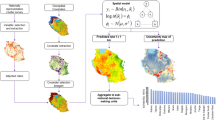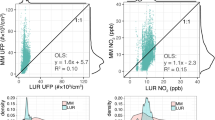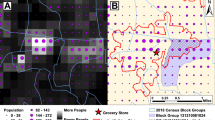Abstract
Human exposure models often make the simplifying assumption that school children attend school in the same census tract where they live. This paper analyzes that assumption and provides information on the temporal and spatial distributions associated with school commuting. The data were obtained using Oak Ridge National Laboratory's LandScan USA population distribution model applied to Philadelphia, PA. It is a high-resolution model used to allocate individual school-aged children to both a home and school location, and to devise a minimum-time home-to-school commuting path (called a trace) between the two locations. LandScan relies heavily on Geographic Information System (GIS) data. With respect to school children attending school in their home census tract, the vast majority does not in Philadelphia. Our analyses found that: (1) about 32% of the students walk across two or more census tracts going to school and 40% of them walk across four or more census blocks; and (2) 60% drive across four or more census tracts going to school and 50% drive across 10 or more census blocks. We also find that: (3) using a 5-min commuting time interval — as opposed to the modeled “trace” — results in misclassifying the “actual” path taken in 90% of the census blocks, 70% of the block groups, and 50% of the tracts; (4) a 1-min time interval is needed to reasonably resolve time spent in the various census unit designations; and (5) approximately 50% of both the homes and schools of Philadelphia school children are located within 160 m of highly traveled roads, and 64% of the schools are located within 200 m. These findings are very important when modeling school children's exposures, especially, when ascertaining the impacts of near-roadway concentrations on their total daily body burden. As many school children also travel along these streets and roadways to get to school, a majority of children in Philadelphia are in mobile source-dominated locations most of the day. We hypothesize that exposures of school children in Philadelphia to benzene and particulate matter will be much higher than if home and school locations and commuting paths at a 1-min time resolution are not explicitly modeled in an exposure assessment. Undertaking such an assessment will be the topic of a future paper.
This is a preview of subscription content, access via your institution
Access options
Subscribe to this journal
Receive 6 print issues and online access
$259.00 per year
only $43.17 per issue
Buy this article
- Purchase on Springer Link
- Instant access to full article PDF
Prices may be subject to local taxes which are calculated during checkout





Similar content being viewed by others
References
Baldauf R., Thoma E., Hayes M., et al. Traffic and meteorological impacts on near-road air quality: summary of methods and trends from the Raleigh Near-Road Study. J Air Waste Manage Assoc 2008: 58: 865–878.
Baxter L.K., Clougherty J.E., Laden F., and Levy J.I. Predictors of concentrations of nitrogen dioxide, fine particulate matter, and particle constituents inside of lower socioeconomic status urban homes. J Expo Sci Environ Epidemiol 2007: 17: 434–444.
Behrentz E., Sabin L.D., and Winer A.M., et al. Relative importance of school bus-related microenvironments to children's pollutant exposure. J Air Waste Manage Assoc 2005: 55: 1418–1430.
Bhaduri B., Bright E., Coelman P., and Urban M. LandScan USA: a high-resolution geospatial and temporal modeling approach for population distribution and dynamics. GeoJournal 2007: 69: 103–117.
Burke J.M., Zufall M.J., and Ozkaynak H. A population exposure model for particulate matter: case study results for PM2.5 in Philadelphia, PA. J Expo Anal Environ Epidemiol 2001: 11: 470–489.
Clougherty J.E., Levy J.I., and Kubzansky L.D., et al. Synergistic effects of traffic-related air pollution and exposure to violence on urban asthma etiology. Environ Health Perspect 2007: 115: 1140–1146.
DeCastro B.R., Sax S.N., and Chillrud S.N., et al. Modeling time-location patterns of inner-city high school students in New York and Los Angeles using a longitudinal approach with generalized estimating equations. J Expo Sci Environ Epidemiol 2007: 17: 233–247.
Dellinger A.M., and Staunton C.E. Barriers to children walking and biking to school – United States, 1999. MMWR 2002: 51: 701–704. CDCgov/mmwr/preview/mmwrhtml/mm5132a1.htm.
Dobson J., Bright E., Coleman P ., et al. LandScan: a global population database for estimating populations at risk. Photogram Eng Remote Sensing 2000: 66: 849–857.
Duncan M.J., and Mummery W.K. GIS or GPS? A comparison of two methods for assessing route taken during active transport. Am J Prev Med 2007: 33: 51–53.
Duncan M.J., Mummery K., and Dascombe B.J. Utility of global positioning system to measure active transport in urban areas. Med Sci Sports Exerc 2007: 39: 1851–1857.
Ebbeling C.B., and Ward A. Assessment of aerobic power/endurance in children. Med Exerc Nutr Health 1992: 1: 230–241.
Eicher C.L., and Brewer C.A. Dasymetric mapping and areal interpolation: implementation and evaluation. Cartogr Geogr Info Sci 2001: 28: 125–138.
Elgethun K., Yost M.G., and Fitzpatrick C.T.E., et al. Comparison of global positioning system (GPS) tracking and parent-report diaries to characterize children's time-location patterns. J Exp Sci Environ Epidemiol 2007: 17: 197–206.
Fitz D.R., Winer A.M., and Colome S., et al. Characterizing the Range of Children's Pollutant Exposure during School Bus Commutes. University of California, Los Angeles, CA, 2003.
Frank L.D., and Engelke P.O. The built environment and human activity patterns: exploring the impacts of urban form on public health. J Plan Liter 2001: 16: 202–218.
Gauderman W.J., Avol E., Lurmann F., et al. Childhood asthma and exposure to traffic and nitrogen dioxide. Epidemiology 2005: 16: 737–743.
Gilliland F., Avol E., and Kinney P., et al. Air pollution exposure assessment for epidemiologic studies of pregnant women and children: Lessons learned from the Centers for Children's Environmental Health and Disease Prevention Research. Environ Health Perspect 2005: 113: 1447–1454.
Green R.S., Smorodinsky S., Kim J.J., et al. Proximity of California public schools to busy roads. Environ Health Perspect 2004: 112: 61–66.
Ham S.A., Macera C.A., and Lindley C. Trends in walking for transportation in the United States, 1995 and 2001. Prev Chronic Dis 2005: 2: 1–11 (www.cdc.gov/pcd/issues/2005/oct/04_0138.htm).
Houston D., Wu J., Ong P., and Winer A. Structural disparities of urban traffic in Southern California: implications for vehicle-related air pollution exposure in minority and high-poverty neighborhoods. J Urban Aff 2004: 26: 565–592.
Kerr J., Rosenberg D., Sallis J.F., et al. Active commuting to school: associations with environment and parental concerns. Med Sci Sports Exerc 2006: 38: 787–794.
Kim J.J., Morodinsky S., Lipsett M., et al. Traffic-related air pollution near busy roads. Am J Respir Crit Care Med 2004: 170: 520–526.
Langford M., and Unwin D. Generating and mapping population density surfaces within a geographical information system. Cartogr J 1994: 31: 21–26.
Lurmann F. Personal communication; September 6 2007.
Martin S., and Carlson S. Barriers to children walking to or from school–United States, 2004. MMWR 2005: 54: 949–952.
Martin S.L., Lee S.M., and Lowry R. National prevalence and correlates of walking and bicycling to school. Am J Prev Med 2007: 33: 98–105.
McCoy M. Jr., Paul R.A., and Johnson T. A Home-to-School Commuting Model for Potential Use in Population Exposure Assessments. American Petroleum Institute, Washington DC, 1999.
McCurdy T., and Graham S. Using human activity data in exposure models: analysis of discriminating factors. J Expo Anal Environ Epidemiol 2004: 13: 294–317.
McDonald N.C. Active transportation to school. Am J Prev Med 2007a: 32: 509–516.
McDonald N.C. Children's mode choice for the school trip: the role of distance and school location in walking to school. Transportation 2007b: doi 10.1007/s11116-007-9135-7.
Mennis J. Generating surface models of population using dasymetric mapping. Prof Geog 2003: 55: 31–42.
Mennis J., and Hultgren T. Intelligent dasymetric mapping and its application to areal interpolation. Cartogr Geog Info Sci 2006: 33: 179–194.
Miller H.J., and Shaw S. Geographic Information Systems For Transportation: Principles and Applications. Oxford University Press, London, 2001.
Monmonier M.S., and Schnell G.A. Land-use and land-cover data and the mapping of population density. Intern Yearbook Cartogr 1984: 24: 115–121.
Patterson L., Urban M., Myers A., et al. Assessing spatial and attribute errors in large national datasets for population distribution models: a case study of Philadelphia County schools. GeoJournal 2007: 69: 93–102.
Pearson R.L., Wachtel H., and Ebi K.L. Distance-weighted traffic density in proximity to a home is a risk factor for leukemia and other childhood cancers. J Air Waste Manage Assoc 2000: 50: 175–180.
Pennsylvania Department of Education. Public, private and nonpublic schools enrollments for 2003–2004: preK-12 schools statistics. www.pde.state.pa.us/k12statistics/cwp/view.asp?A=3&Q=105752(1/27/2007).
Princiotta D., Bielick S., and Chapman C. 1.1 million home-schooled students in the United States in 2004, 2004 National Center for Educational Statistics Report # 2004-115 nces.ed.gov/pubsearch/pubsinfo.asp?pubid=2004115(12/27/2007).
PSD (Philadelphia School District). Transportation Fact Sheet, webgui.phila.k.12.pa.us.html(12/27/2007) 2007.
Sabin L.D., Behrentz E., and Winer A.M., et al. Characterizing the range of children's air pollution exposure during school bus commutes. J Expo Anal Environ Epidemiol 2004: 15: 377–387.
Saksvig B.I., Catellier D.J., and Pfeiffer K., et al. Travel by walking before and after school and physical activity among adolescent girls. Arch Pediatr Adoles Med 2007: 161: 153–158.
Stevens W. Personal communication: traffic count information for the County of Philadelphia. (www.dvrpc.org/asp/traffic/trafficcount.htm), 2007.
US EPA. Human Exposure Modeling—Air Pollutants Exposure Model (APEX / TRIM.Expo), www.epa.gov/ttn/fera/human-apex.html, 2007.
Wilhelm M., and Ritz B. Residential proximity to traffic and adverse birth outcomes in Los Angeles County, California, 1994–1996. Environ Health Perspect 2003: 111: 207–216.
Wright J. A method of mapping densities of population: Cape Cod as an example. Geograph Rev 1936: 26: 103–110.
Acknowledgements
The LandScan work was done under contract to Oak Ridge National Laboratory through Interagency Agreement #DW89921830 funded by the US Environmental Protection Agency (EPA). Oak Ridge staffs who played an important role in the project include Eddie Bright and Marie Minner. We acknowledge their fine work on obtaining and organizing land use and GIS data in Philadelphia. We greatly acknowledge the fast work by Will Stevens of the Delaware Valley Regional Planning Commission to provide us with link-specific ADT data in Philadelphia. We also acknowledge the input provided by Dr. Lisa Baxter as part of EPA's internal review process; she sharpened up the focus of our paper. The two anonymous reviewer comments also made us clarify our wording in a number of places, and we appreciate their input. This paper has been subject to Agency review and approved for publication, but does not necessarily constitute an endorsement of our findings. Mention of trade names, commercial products, and organizations does not constitute endorsement or recommendation for use.
Author information
Authors and Affiliations
Corresponding author
Rights and permissions
About this article
Cite this article
Xue, J., McCurdy, T., Burke, J. et al. Analyses of school commuting data for exposure modeling purposes. J Expo Sci Environ Epidemiol 20, 69–78 (2010). https://doi.org/10.1038/jes.2009.3
Received:
Accepted:
Published:
Issue Date:
DOI: https://doi.org/10.1038/jes.2009.3
Keywords
This article is cited by
-
Breaking Out of Surveillance Silos: Integrative Geospatial Data Collection for Child Injury Risk and Active School Transport
Journal of Urban Health (2016)
-
Use of an exposure model to explore the impact of residential proximity to a highway on exposures to air pollutants of an ambient origin
Air Quality, Atmosphere & Health (2016)
-
Statistical properties of longitudinal time-activity data for use in human exposure modeling
Journal of Exposure Science & Environmental Epidemiology (2013)



